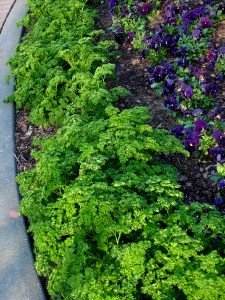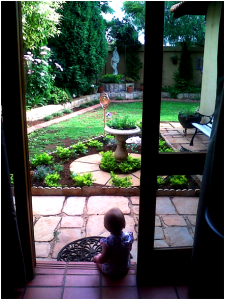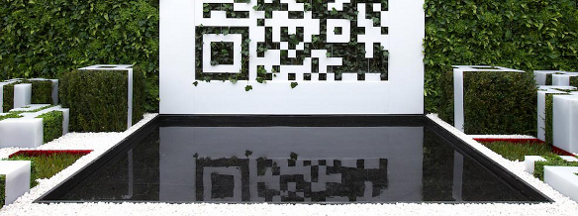Some people believe that the first landscaped gardens belonged to the Chinese and others say it was developed by the Romans and Egyptians. Whichever it was, it really came into its own during the Victorian era during which time glass houses, pouring cement and many garden tools were invented such as a horse-drawn lawn mower. Plants were collected from excursions to exotic places and cultivated and seeded for re-distribution.
Landscaping, or garden design, is the gardening equivalent of interior decorating. Decorating a public building such as a library would require implementing the ‘rules’ of design on a different scale to that of a home office. The same applies to the library gardens as opposed to the home garden. In the same vein, landscaping goes through trends or fashions just as interior decorating does while keeping the basic rules and styles of design in mind.
As with all design the debate over function and form which has raged for over a century has become prevalent in garden landscaping too. People in every design discipline have wrestled with it from time to time. At the Chelsea Flower Show last year function took over form in many ways; carbon-neutral energy systems, vertical vegetable gardens, wormeries and bug hotels, for example. This year however, form seemed to take prevalence with an increased interest in how nature and artifice find their place side by side to create pleasure and inspiration in the garden. Geometric lines and formal clipped hedges and topiaries were softened with woodland grasses and self-seeding plants. ‘Futurism’ is a new trend too, shown in a seven story scaffold tower that explored the idea of gardening in the future. A rooftop garden looked at the workplace of the future. Doesn’t a rooftop garden office sound heavenly?
This year designers were encouraged to think outside the proverbial box and they explored how technology can impact the design of gardens. Of course techno art and water recycling came to the fore, but more interesting than that was Quick Response Code technology. Visitors scanned a vertical garden that was in the form of a QR code with their mobile phones and it took them to a website that provided more information on the plants used. Who would’ve thought, hey!
The fashion this year includes soft blues, pinks and mauves with just touches of red and burgundy on a background of silver and greys. Natural materials such as wood and stone are the landscaping materials of choice. Lawns are becoming passé and being replaced with meadow mix plantings and water-wise alternatives such as gravel. Harvesting of rainwater and water-wise plantings are big, not just in South Africa, but even in the wet and wonderful UK.
 As our society changes and becomes more technologically driven, people are spending more time at home with many working from their homes rather than commuting. The downturn in the world economy and subsequent increase in crime has coined the term cocooning as people work, entertain, relax and holiday in their homes. With that comes the need for space and since that is bought at a premium around the world, most homes are now designed for indoor/outdoor living in order to meet the need. The return to natural living has seen many vegetable and herb gardens (potagers) being developed or herbs and vegetables being introduced in an ornamental garden. Parsley borders are extremely beautiful, for example.
As our society changes and becomes more technologically driven, people are spending more time at home with many working from their homes rather than commuting. The downturn in the world economy and subsequent increase in crime has coined the term cocooning as people work, entertain, relax and holiday in their homes. With that comes the need for space and since that is bought at a premium around the world, most homes are now designed for indoor/outdoor living in order to meet the need. The return to natural living has seen many vegetable and herb gardens (potagers) being developed or herbs and vegetables being introduced in an ornamental garden. Parsley borders are extremely beautiful, for example.
While rules were made to be broken, with some great results in garden design, there are a couple of principles that should always be kept in mind while planning. The most important one, I believe, is that the more research and planning you do before actually picking up the spade, the more satisfactory the results you achieve will be. Every step in this process is exciting and fulfilling and the planning stages can be done from the comfort of your armchair. When researching, look through books, magazines and websites to find ideas, styles and schemes that you absolutely love. Many of these can be incorporated into areas of your garden, although they may need some tweaking according to size and proportion, later. Print pictures, or cut them out and make a mood board of ideas as a reference which you will continually visit during the creation of your garden. A mood board can be made on a pin board or a piece of cardboard and is basically a ‘scrapbook’ page or a visual reminder. Or use Pinterest as an online collection of images and ideas that inspire.
Whether you have an established garden, an undeveloped or newly developed stand or a neglected garden, there are a few questions you must ask in order to ensure that the best use is made of the property available to you. Even if you just want something that is easy to maintain or you want to throw concrete down to avoid having to mow a lawn, one should consider the following;
- Where does the sun rise and set in this property?
- Are you in the southern or northern hemisphere?
- What is the climate like in your area?
- Who will be using the property; adults, children, pets, or visitors on occasion?
- What will they be using the property for; play, exercise, relaxing, reading, planting, planting and harvesting?
- What is the architectural style of your home?
- Do you want to design your garden in line with your home or do you want to highlight certain architectural aspects of it?
- Do you want a maintenance-free garden or do you enjoy doing the maintenance yourself? Remember that gardening is great exercise, too.
- Do you have a swimming pool, braai or barbecue area?
- Do you particularly want to attract birds and butterflies in your garden?
- Do you want a potager?
- Do you want cut flowers?
- Make a list of your likes and dislikes.
- What are you prepared to spend and over what period are you prepared to do it?
- Do you have architectural drawing or plans of the property? They will come in handy when drawing your garden plan.
 In speaking to property brokers, most of them believe that a beautifully established and well maintained garden can make a big difference to a property being sold at asking price. Beside the monetary investment, a garden is a soulful place and psychologists will tell you that ‘getting back to basics’ is therapeutic and healing. A garden is great for developing children’s awareness of their surroundings, their imagination and caring for their environment. Trees keep your environment clean and healthy and on that note; did you know that Gauteng in South Africa is the largest man-made forest in the world?
In speaking to property brokers, most of them believe that a beautifully established and well maintained garden can make a big difference to a property being sold at asking price. Beside the monetary investment, a garden is a soulful place and psychologists will tell you that ‘getting back to basics’ is therapeutic and healing. A garden is great for developing children’s awareness of their surroundings, their imagination and caring for their environment. Trees keep your environment clean and healthy and on that note; did you know that Gauteng in South Africa is the largest man-made forest in the world?
In future articles, I will cover the detail of landscaping, incorporating principles, show you how to draw a plan, choose plants, décor ideas and incorporate security while growing a beautiful garden that you will want to spend time in. This is just the beginning; you are in for a treat!


